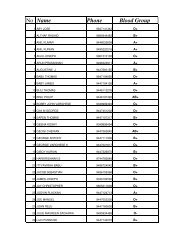Vol 34 No 2 suppli final.pmd - IDA KERALA STATE ::. idakerala.com
Vol 34 No 2 suppli final.pmd - IDA KERALA STATE ::. idakerala.com
Vol 34 No 2 suppli final.pmd - IDA KERALA STATE ::. idakerala.com
Create successful ePaper yourself
Turn your PDF publications into a flip-book with our unique Google optimized e-Paper software.
On publishing an article<br />
Publishing has be<strong>com</strong>e a <strong>com</strong>pulsion and hence editorial offices of journals are<br />
flooded with articles. This is no reflection of the scientific activities that take place<br />
in the dental colleges. Majority of the articles fall into two categories: over view of<br />
a topic (the so called review) and case reports. On most of the occasions the<br />
former is a direct adaptation of text books and the latter, the report of singular<br />
case. Most of the articles when submitted do not follow the basic rules described<br />
in the 'Uniform Requirements for Manuscripts Submitted to Biomedical Journals:<br />
Writing and Editing for Biomedical Publication' (Updated April 2010) published<br />
by the International Committee of Medical Journal Editors.<br />
Who is an author: Authorship credit should be based on 1) substantial contributions<br />
to conception and design, acquisition of data, or analysis and interpretation of<br />
data; 2) drafting the article or revising it critically for important intellectual content;<br />
and 3) <strong>final</strong> approval of the version to be published. Authors should meet conditions<br />
1, 2, and 3. All persons designated as authors should qualify for authorship, and all<br />
those who qualify should be listed.<br />
Protection of Human Subjects and Animals in Research: When reporting<br />
experiments on human subjects, authors should indicate whether the procedures<br />
followed were in accordance with the ethical standards of the responsible <strong>com</strong>mittee<br />
on human experimentation (institutional and national) and with the Helsinki<br />
Declaration of 1975, as revised in 2008. When reporting experiments on animals,<br />
authors should indicate whether the institutional and national guide for the care<br />
and use of laboratory animals was followed.<br />
Duplicate Submission: Most biomedical journals will not consider manuscripts<br />
that are simultaneously being considered by other journals.<br />
Preparing a Manuscript for Submission: Editors and reviewers spend many hours<br />
reading the manuscripts, and therefore appreciate receiving manuscripts that are<br />
easy to read and edit. The text of observational and experimental articles is usually<br />
divided into the following sections: Introduction, Methods, Results, and Discussion.<br />
This so-called "IMRAD" structure is not an arbitrary publication format but rather<br />
a direct reflection of the process of scientific discovery. Other types of articles,<br />
such as case reports, reviews, and editorials, probably need to be formatted<br />
differently.<br />
Double-spacing all portions of the manuscript-including the title page, abstract,<br />
text, acknowledgments, references, individual tables, and legends-and generous<br />
margins make it possible for editors and reviewers to edit the text line by line and<br />
add <strong>com</strong>ments and queries directly on the paper copy. If manuscripts are submitted<br />
electronically, the files should be double-spaced to facilitate printing for reviewing<br />
and editing. Authors should number all of the pages of the manuscript consecutively,<br />
beginning with the title page, to facilitate the editorial process.<br />
KDJ - <strong>Vol</strong>.<strong>34</strong>, <strong>No</strong>. 1 Supplement, March 2011<br />
Editorial<br />
Dr. K. Nandakumar<br />
93




